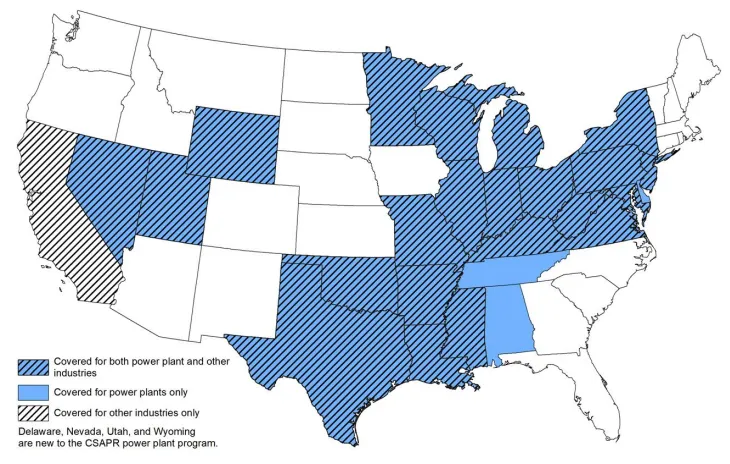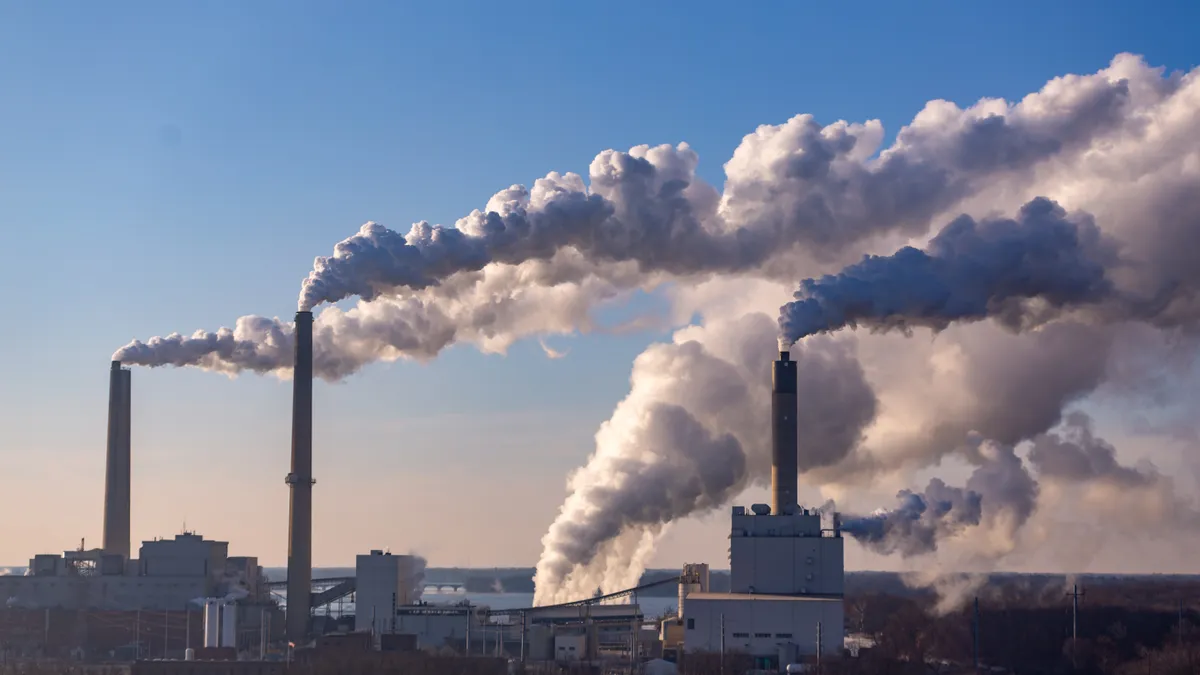Dive Brief:
-
The Environmental Protection Agency’s proposal to tighten its regional ozone transport rule could speed up the pace of power plant retirements and threaten grid reliability, according to major grid operators, at least a dozen state utility commissions, rural and public power utilities, and a group of Republican attorneys general.
-
The EPA’s proposed federal implementation plan addressing ozone transport for the 2015 ozone air quality standard would likely force up to 42 GW of coal generation in 25 states to retire in 2026 because it would be too costly to install required selective catalytic reduction (SCR) equipment on those plants, the National Rural Electric Cooperative Association said in comments filed June 21 with the agency.
-
The Edison Electric Institute, a trade group for investor-owned utilities, generally supported the proposal, but suggested some changes, including using electrification to reduce emissions of nitrogen oxide, or NOx, an ozone precursor, from industrial and other sectors.
Dive Insight:
The EPA in February proposed an allowance-based ozone season trading program with NOx emissions budgets for fossil fuel-fired power plants in 25 states whose emissions prevent downwind states from meeting National Ambient Air Quality Standards, or NAAQS, for ozone. The proposed rule, which also covers some industrial sources, aims to reduce the amount of ozone and NOx that drifts into downwind states.
The program would begin in 2023 and three years later the emissions budgets would be set at levels that can be achieved by adding SCRs to the roughly 30% of large coal-fired generators that don’t have them, leading to a 29% cut in ozone-season NOx emissions from power plants in the covered states, according to the EPA.

The proposed rule would prevent about 1,000 premature deaths in 2026 and would produce about $15 billion in net annual benefits through 2042, according to the EPA. The agency said it would cost about $1.1 billion in 2026 to comply with the proposal, increasing electricity costs by about 1%.
States could propose their own implementation plans to avoid the federal plan.
The agency expects the proposed rule could cause about 18 GW of coal-fired generation and 4 GW of oil- and gas-fired units to retire by 2030.
Pointing to already tightening reserve margins, four grid operators — the Electric Reliability Council of Texas, Midcontinent Independent System Operator, PJM Interconnection and the Southwest Power Pool — jointly urged the EPA to include a “reliability safety valve” in any final rule, which would ensure generation critical to the grid doesn’t retire early due to this ruling.
The grid operators didn’t propose a specific safety valve, but in a separate filing MISO proposed letting power plants operate outside the emissions limits for 90 days if a grid operator declares an emergency.
The EPA could also create a bank of “reliability” allowances that could be used during emergencies, according to MISO.
Utility regulators in SPP’s footprint said the EPA should provide more time for generators to meet the proposed rule so that replacement power plants can be built.
“In addition to the time required for regulatory approvals and construction of generation and transmission facilities, the process for interconnecting generation to transmission in SPP and other organizations is experiencing ongoing delays,” the SPP Regional State Committee said.
Up to 8,200 MW of coal capacity and up to 2,600 MW of natural gas capacity could retire in the Electric Reliability Council of Texas footprint because of the rule, leading to a sharply higher probability of planned blackouts, according to comments filed by the Texas Public Utility Commission.
“There is a natural pace of change in grid resources due to advancing technologies and changing market conditions,” the Texas PUC said. “There is a limit to how fast this change can occur within acceptable reliability constraints.”
The Large Public Power Council, an interest group for consumer-owned utilities, said the EPA should evaluate how potential power plant shutdowns would affect the grid, especially as the power sector transitions towards clean energy.
The EPA should work with the Federal Energy Regulatory Commission, regional transmission organizations and state utility commissions to study how the rule and other pending regulations could affect the power system, according to the LPPC.
The agency should also include a “reliability adjustment mechanism” in its plan so NOx emissions limits could be eased if grid reliability is threatened, the public power group said.
A group of Republican attorneys general urged FERC to dump its plan, saying it exceeded the agency’s authority, was too restrictive and shouldn’t apply to non-generating sources.
Meanwhile, EEI urged the EPA to consider ways to support electrification as a way to reduce NOx and volatile organic compound emissions. The agency, for example, should offer an abbreviated “state implementation plan” pathway for states to get credit for electrification measures, such as installed electric vehicle chargers, that reduce ozone precursor emissions, the trade group said.
Environmental groups, led by Earthjustice, largely supported the plan, but argued that updated modeling shows that Arizona, New Mexico, North Carolina and Oregon should likely be covered by the proposal.
The EPA should tighten the emissions budgets to better reflect how effective pollution control equipment can be, according to the groups.
EPA should also include cogeneration units within the power plant emissions trading program if they meet applicability criteria, along with boilers and combustion turbines serving generators that provide electricity for cryptocurrency mining, the groups said.
The EPA aims to issue a final rule in March, according to the Office of Management and Budget’s most recent regulatory agenda.














